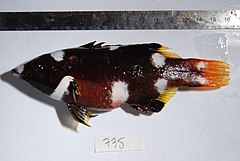Diagnostic Description
provided by Fishbase
Juveniles and females easily recognized by the generally black body with large white spots; males have large black spots on the soft parts of the dorsal and anal fins (Ref. 48636). Juveniles resemble the juveniles of B. mesothorax but have white rather than yellow spots. Undergoes a dramatic color change with growth.
Life Cycle
provided by Fishbase
Oviparous, distinct pairing during breeding (Ref. 205).
Morphology
provided by Fishbase
Dorsal spines (total): 12; Dorsal soft rays (total): 9 - 10; Analspines: 3; Analsoft rays: 12 - 13
Trophic Strategy
provided by Fishbase
Occurs inshore (Ref. 75154). Adults inhabit clear lagoon and seaward reefs (Ref. 1602); common in clear shallow waters at 1-8 m; large individuals occasionally at greater depths below 27 m (Ref. 75973). Juveniles occur solitary in caves or under ledges and act as cleaners by picking at bodies of other fishes (adults occasionally do this) (Ref. 1602); occurring regularly at depths of 14-26 m (Ref. 75973).
Biology
provided by Fishbase
Adults inhabit clear lagoon and seaward reefs (Ref. 1602); common in clear shallow waters at 1-8 m; large individuals occasionally at greater depths below 27 m (Ref. 75973). Juveniles occur solitary in caves or under ledges and act as cleaners by picking at bodies of other fishes (adults occasionally do this) (Ref. 1602); occurring regularly at depths of 14-26 m (Ref. 75973). Feed mainly on benthic, hard-shelled, invertebrates such as mollusks and crustaceans (Ref. 9823). Oviparous, distinct pairing during breeding (Ref. 205). Not commonly marketed. Occasionally seen in the aquarium trade.
- Recorder
- Estelita Emily Capuli
Importance
provided by Fishbase
fisheries: minor commercial; aquarium: commercial; bait: occasionally; price category: very high; price reliability: very questionable: based on ex-vessel price for species in this family
- Recorder
- Estelita Emily Capuli
分布
provided by The Fish Database of Taiwan
分布於印度-太平洋區,由紅海、南非到馬歇爾、馬貴斯及土木土群島,北至日本琉球與台灣海域等。台灣除西部外,各地海域皆有分布。
利用
provided by The Fish Database of Taiwan
中小型之隆頭魚,幼魚和成魚的體色都非常鮮明,所以在水族館裏偶爾可以看到它的蹤影。亦可食用,延繩釣、一支釣較容易上鉤。
描述
provided by The Fish Database of Taiwan
體長型,側扁;頭尖;眼眶間隔稍凸。眼眶前與前鰓蓋被鱗。齒圓錐狀,上下頜前側具
2對犬齒。D. XII, 10;A. III, 12;P. 15-16;L.l. 30-31;G.R.
5+12;背鰭軟條部圓形;臀鰭第III棘長且硬;腹鰭尖形;尾鰭稍圓。幼於體一至呈黑色;頭部及體側共約散佈9個白色圓班。成魚體前部紫褐色,後半部黃紅色;背鰭棘部及軟條部各具一黑點;胸鰭基與臀鰭軟條各具一圓黑斑;腹鰭黃色,外緣黑色;背鰭軟條、臀鰭、胸鰭與尾鰭淡黃色。
棲地
provided by The Fish Database of Taiwan
主要棲息於乾淨的珊瑚礁潟湖和珊瑚礁向海面,深度範圍可從2公尺到水深100公尺左右。多單獨在亞潮帶較深水域的礁岩洞穴陰暗處活動,很少游到空曠的地方。幼魚通常可以在暗礁下面或礁洞被發現,和裂唇魚一樣愛做「魚醫生」,專門啄食其他魚種身上的寄生物,成魚後以具硬殼之底棲性無脊椎動物,像軟體動物和甲殼類等為食。
Bodianus axillaris
provided by wikipedia EN
Bodianus axillaris, the axilspot hogfish, coral pigfish or turncoat hogfish, is a species of wrasse native to the Indo-Pacific.

Bodianus axillaris, female
Description
The axilspot hogfish is sexually dimorphic with the adult males being coloured reddish-brown on the front part of their bodies contrasting with the white posterior end and having a sizeable black spot at the base of the pectoral fin, as well as on the dorsal and anal fins. The females and the juveniles are a blackish colour marked with white blotches along the upper and lower flanks. The juveniles of this species resemble those of the split-level hogfish (Bodianus mesothorax) but possess white instead of yellow spots.[3] It grows to a standard length of 20 centimetres (7.9 in).[2]
Distribution
Axilspot hogfish are found in the Indo-Pacific, from the Red Sea to South Africa, Marshall Islands, Marquesan, and Tuamoto Islands, north to Japan.[2]
Habitat and biology
The adults of the axilspot hogfish are found in clear lagoon and along seaward reefs where they are common in clear shallow waters at depths of between 1 and 8 metres (3.3 and 26.2 ft). The larger fish are occasionally found in deeper water below 27 metres (89 ft). The juveniles are found singly in caves or under overhangs where they behave as cleaner fish, adults will sometimes behave in this way too. Their diet is made up of benthic, hard-shelled, invertebrates such as molluscs and crustaceans. It is oviparous and the males and females form distinct pairs when spawning.
Human use
It is infrequently encountered in the aquarium trade,[3] and is not a species of interest to commercial fisheries.[2]
Species description
The axilspot hogfish was formally described by the English zoologist Edward Turner Bennett as Labrus axillaris in 1832 with the type locality being given as Mauritius.[4]
References

- license
- cc-by-sa-3.0
- copyright
- Wikipedia authors and editors
Bodianus axillaris: Brief Summary
provided by wikipedia EN
Bodianus axillaris, the axilspot hogfish, coral pigfish or turncoat hogfish, is a species of wrasse native to the Indo-Pacific.

Bodianus axillaris, female
- license
- cc-by-sa-3.0
- copyright
- Wikipedia authors and editors
Description
provided by World Register of Marine Species
Inhabits clear lagoon and seaward reefs. Juveniles are usually found in caves or under ledges and act as cleaners by picking at bodies of other fishes (adults occasionally do this) (Ref. 1602). Feeds mainly on benthic, hard-shelled, invertebrates such as molluscs and crustaceans (Ref. 9823). Not commonly marketed for food. Occasionally seen in the aquarium trade.
Froese, R. & D. Pauly (Editors). (2023). FishBase. World Wide Web electronic publication. version (02/2023).
- license
- cc-by-4.0
- copyright
- WoRMS Editorial Board


 Bodianus axillaris, female
Bodianus axillaris, female